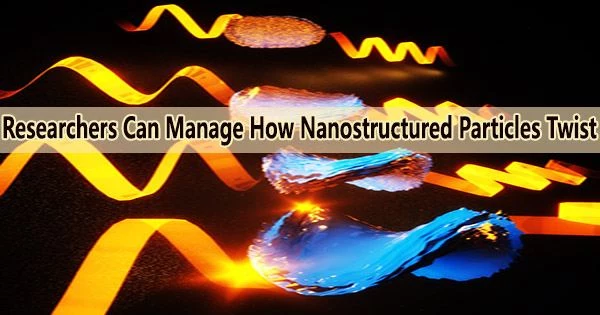A research team lead by the University of Michigan has demonstrated that micron-sized “bow ties,” self-assembled from nanoparticles, generate a range of distinct curling shapes that can be precisely controlled.
The discovery makes it possible to produce materials that interact with twisted light with ease, as well as new machine vision tools and pharmaceuticals.
While chiral structures, such as DNA, are abundant in life, their degree of twist cannot be changed without the structure breaking. Now, researchers can engineer the degree of twist.
Such materials could enable robots to accurately navigate complex human environments. Instead of the 2D arrangement of symbols that makes up the majority of signs that humans can read, twisted structures would encode information in the shapes of the light waves that reflect from the surface. This would make use of polarization, a property of light that humans can hardly perceive.
Some types of circularly polarized light, which has a form that twists as it travels across space, are preferentially reflected by the twisted nanostructures.
“It is basically like polarization vision in crustaceans,” said Nicholas Kotov, the Irving Langmuir Distinguished University Professor of Chemical Sciences and Engineering, who led the study. “They pick up a lot of information in spite of murky environments.”
Machines may be able to interpret symbols that appear to humans as white dots; the information would be stored in the combination of frequencies reflected, twist tightness, and left or right-handedness.
Not only do we know the progression from the atomic scale all the way up to the micron-scale of the bow ties, we also have theory and experiments that show us the guiding forces. With that fundamental understanding, you can design a bunch of other particles.
Thi Vo
Robots are less likely to miss or misinterpret a cue by eliminating the use of natural and ambient light and relying instead on circularly polarized light generated by the robot, whether in bright or dark surroundings. Materials that can selectively reflect twisted light, known as chiral metamaterials, are usually hard to make but bow ties aren’t.
“Previously, chiral metasurfaces have been made with great difficulty using multimillion-dollar equipment. Now, these complex surfaces with multiple attractive uses can be printed like a photograph,” Kotov said.
Moreover, chiral medications, which are difficult to make with the proper molecular twist, may be produced under the right circumstances with the aid of twisted nanostructures.
“What hasn’t been seen in any chiral systems before is that we can control the twist from a fully twisted left-handed structure to a flat pancake to a fully twisted right-handed structure. We call this a chirality continuum,” said Prashant Kumar, a U-M postdoctoral research fellow in chemical engineering and first author of the study in Nature.
By combining the bow ties with polyacrylic acid and dabbing them onto glass, fabric, plastic, and other surfaces, Kumar experimented with the bow ties as a kind of paint. Laser experiments revealed that this paint only reflected twisted light when the light’s twist matched the bow tie’s twist.
Cadmium metal and cystine, a protein fragment available in left- and right-handed varieties, are combined in lye-infused water to create the bow ties. Left-handed bow ties developed if the cystine was exclusively left-handed, whereas right-handed bow ties with candy-wrapper twists emerged from right-handed cystine.
But with different ratios of left-and right-handed cystine, the team made intermediate twists, including the flat pancake at a 50-50 ratio. The pitch of the tightest bow ties, basically the length of a 360-degree turn, is about 4 microns long within infrared light’s range of wavelengths.
“Not only do we know the progression from the atomic scale all the way up to the micron-scale of the bow ties, we also have theory and experiments that show us the guiding forces. With that fundamental understanding, you can design a bunch of other particles,” said Thi Vo, a former U-M postdoctoral researcher in chemical engineering.
He worked with Sharon Glotzer, co-corresponding author of the study, and the Anthony C. Lembke Department Chair of Chemical Engineering at U-M.
In contrast with other chiral nanostructures, which can take days to self-assemble, the bow ties formed in just 90 seconds. The team produced 5,000 different shapes within the bow tie spectrum. They studied the shapes in atomic detail using X-rays at Argonne National Laboratory ahead of the simulation analysis.
Collaborators at U-M, the University of Pennsylvania, the University of Palermo in Italy, and Pro Vitam Ltd, Romania, provided additional material analysis and contributions to theory. The Office of Naval Research, National Science Foundation, and Army Research Office supported the study.
Kotov is also the Joseph B. and Florence V. Cejka Professor of Engineering and a professor of chemical engineering and macromolecular science and engineering. Vo is now a professor of chemical and biomolecular engineering at Johns Hopkins University. Glotzer is also the John Werner Cahn Distinguished University Professor of Engineering, the Stuart W. Churchill Collegiate Professor of Chemical Engineering, and a professor of materials science and engineering, macromolecular science and engineering, and physics.





